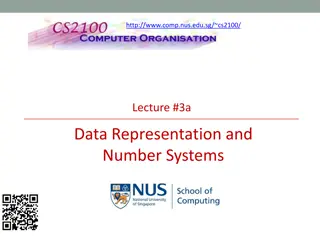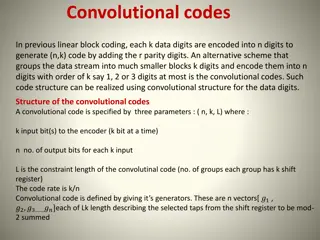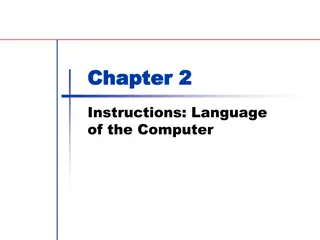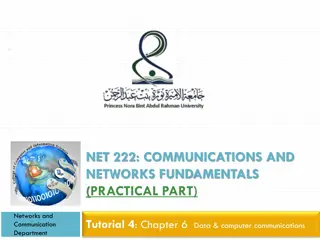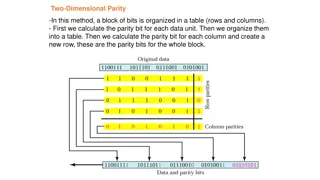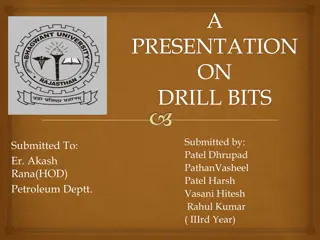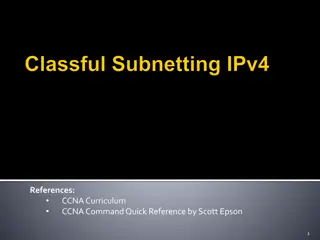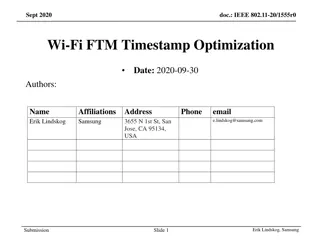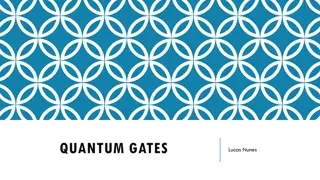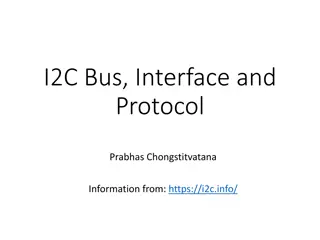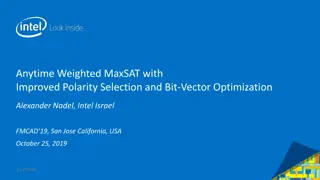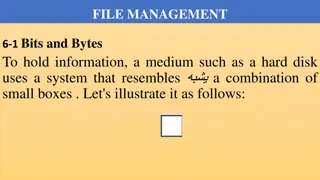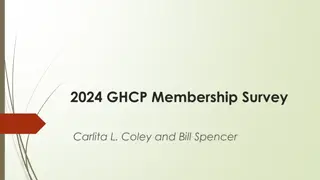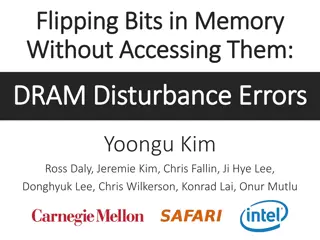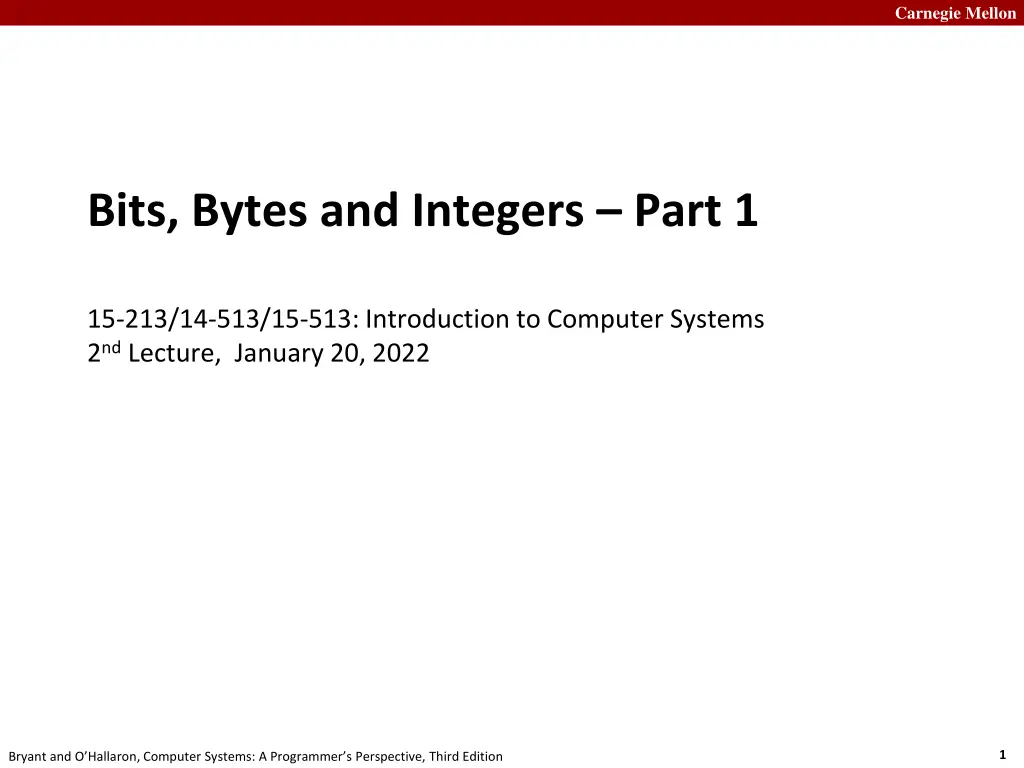
Carnegie Mellon Computer Systems Lecture Updates and Announcements
Stay updated with Carnegie Mellon's Computer Systems course announcements, lab availability, and lecture slide distribution. Get details on recitations, Autolab access, lab deadlines, and more. Enhance your learning experience with timely information and resources.
Download Presentation

Please find below an Image/Link to download the presentation.
The content on the website is provided AS IS for your information and personal use only. It may not be sold, licensed, or shared on other websites without obtaining consent from the author. If you encounter any issues during the download, it is possible that the publisher has removed the file from their server.
You are allowed to download the files provided on this website for personal or commercial use, subject to the condition that they are used lawfully. All files are the property of their respective owners.
The content on the website is provided AS IS for your information and personal use only. It may not be sold, licensed, or shared on other websites without obtaining consent from the author.
E N D
Presentation Transcript
Carnegie Mellon Bits, Bytes and Integers Part 1 15-213/14-513/15-513: Introduction to Computer Systems 2ndLecture, January 20, 2022 1 Bryant and O Hallaron, Computer Systems: A Programmer s Perspective, Third Edition
Carnegie Mellon Announcements Recitations begin next Monday January 24 Zoom links on Piazza Linux Boot Camp Sunday January 23 More info on Piazza Autolab, Piazza, Canvas rosters update once a day Please be patient if you just enrolled You can start labs 0 and 1 without Autolab access We will give extensions for anything you couldn t turn in because you weren t on the roster 2 Bryant and O Hallaron, Computer Systems: A Programmer s Perspective, Third Edition
Carnegie Mellon Announcements Lab 0 is now available via schedule page and Autolab. Due Tuesday January 25, 11:59pm ET No grace days, no late submissions Should take you less than five hours Links on schedule page no longer go to Autolab Lab 1 will become available at 3pm today Due February 3, 11:59pm ET One grace day If you re done with lab 0, now is a good time to start Links will be added to schedule page 3 Bryant and O Hallaron, Computer Systems: A Programmer s Perspective, Third Edition
Carnegie Mellon Timing of lecture slide distribution Historically we post lecture slides after each lecture We are frequently asked to post them before each lecture Typical request: It would help me follow along, and I could look over the slides beforehand and come prepared with questions Educational research suggests this is a good idea Raver and Maydosz, Impact of the provision and timing of instructor-provided notes on university students learning, Active Learning in Higher Education 11(3) 189 200, 2010 Mooney and Bergin, An analysis of alternative approaches for the distribution of lecture notes with the aid of a virtual learning environment to promote class engagement, All Ireland Journal of Higher Education 6(2), 2014 Faculty will discuss this and decide by next week 4 Bryant and O Hallaron, Computer Systems: A Programmer s Perspective, Third Edition
Carnegie Mellon How to download labs directly to sharks On a shark machine: cd private/15213 autolab download 15213-f21:labname cd labname tar -x --strip=1 -f labname-handout.tar labname is the name from the website, but all lowercase letters all spaces removed for example: C Programming Lab cprogramminglab You may need to run autolab setup first Only once ever You need to do that anyway, so make submit works Note: procedure will change starting with cache lab 5 Bryant and O Hallaron, Computer Systems: A Programmer s Perspective, Third Edition
Carnegie Mellon Today: Bits, Bytes, and Integers Representing information as bits Bit-level manipulations Integers Representation: unsigned and signed Conversion, casting Expanding, truncating Addition, negation, multiplication, shifting Summary today next lecture Representations in memory, pointers, strings 6 Bryant and O Hallaron, Computer Systems: A Programmer s Perspective, Third Edition
Carnegie Mellon Everything is bits Each bit is 0 or 1 By encoding/interpreting sets of bits in various ways Computers determine what to do (instructions) and represent and manipulate numbers, sets, strings, etc Why bits? Electronic Implementation Easy to store with bistable elements Reliably transmitted on noisy and inaccurate wires 0 1 0 1.1V 0.9V An Amazing & Successful Abstraction. 0.2V (which we won t dig into in 213) 0.0V 7 Bryant and O Hallaron, Computer Systems: A Programmer s Perspective, Third Edition
Carnegie Mellon For example, can count in binary Base 2 Number Representation 0, 1, 10, 11, 100, 101, Represent 1521310 as 0011 1011 0110 11012 Represent 1.2010as 1.0011 0011 0011 0011 [0011] 2 Represent 1.5213 104 10 as 1.1101 1011 0110 1 213 2 Represent negative numbers as ? (we ll come back to this) 8 Bryant and O Hallaron, Computer Systems: A Programmer s Perspective, Third Edition
Carnegie Mellon Encoding Byte Values 0 1 2 3 4 5 6 7 8 9 A B C D E F 0 1 2 3 4 5 6 7 8 9 10 11 12 13 14 15 0000 0001 0010 0011 0100 0101 0110 0111 1000 1001 1010 1011 1100 1101 1110 1111 Byte = 8 bits Decimal: 010 to 25510 255 = 28 1 Binary: 0000 00002 to 1111 11112 Hexadecimal: 0016 to FF16 Base 16 number representation Use characters 0 to 9 and A to F Write in C with leading 0x , either case 0101 10102 = 0x5a = 0x5A = 0X5a 15213: 0011 1011 0110 1101 3 B 6 D 9 Bryant and O Hallaron, Computer Systems: A Programmer s Perspective, Third Edition
Carnegie Mellon Combine bytes to make scalar data types Size (# of bytes) C Data Type Typical 32-bit Typical 64-bit char 1 1 short 2 2 int 4 4 long 4 8 float 4 4 double 8 8 pointer 4 8 ILP32 LP64 10 Bryant and O Hallaron, Computer Systems: A Programmer s Perspective, Third Edition
Carnegie Mellon Today: Bits, Bytes, and Integers Representing information as bits Bit-level manipulations Integers Representation: unsigned and signed Conversion, casting Expanding, truncating Addition, negation, multiplication, shifting Summary today next lecture Representations in memory, pointers, strings 11 Bryant and O Hallaron, Computer Systems: A Programmer s Perspective, Third Edition
Carnegie Mellon Boolean Algebra Developed by George Boole in 19th Century Algebraic representation of logic Encode True as 1 and False as 0 And Or A&B = 1 when both A=1 and B=1 A|B = 1 when either A=1 or B=1 or both 0 0 1 1 1 1 0 0 0 1 0 1 | 0 1 & 0 1 Not Exclusive-Or (Xor) ~A = 1 when A=0 A^B = 1 when A=1 or B=1, but not both 0 1 1 0 0 0 1 1 1 0 ~ ^ 0 1 12 Bryant and O Hallaron, Computer Systems: A Programmer s Perspective, Third Edition
Carnegie Mellon General Boolean Algebras Operate on Bit Vectors Operations applied bitwise 01101001 & 01010101 01000001 01000001 01101001 | 01010101 01111101 01111101 01101001 ^ 01010101 00111100 00111100 ~ 01010101 10101010 10101010 All of the Properties of Boolean Algebra Apply 13 Bryant and O Hallaron, Computer Systems: A Programmer s Perspective, Third Edition
Carnegie Mellon Example: Sets of Small Integers Width ? bit vector represents subsets of {?,?, ,? ?} Let ? be a bit vector representing set ?, then bit ??= 1 if ? ? Examples: { 0, 3, 5, 6 } 76543210 { 0, 2, 4, 6 } 76543210 01101001 01010101 Operations & Intersection | Union ^ Symmetric difference ~ Complement 01000001 01111101 00111100 10101010 { 0, 6 } { 0, 2, 3, 4, 5, 6 } { 2, 3, 4, 5 } { 1, 3, 5, 7 } 14 Bryant and O Hallaron, Computer Systems: A Programmer s Perspective, Third Edition
Carnegie Mellon Bit-Level Operations in C Operations &, |, ~, ^ Available in C Apply to any integral data type 0 1 2 3 4 5 6 7 8 9 A B C D E F 0 1 2 3 4 5 6 7 8 9 10 11 12 13 14 15 0000 0001 0010 0011 0100 0101 0110 0111 1000 1001 1010 1011 1100 1101 1110 1111 long, int, short, char, unsigned View arguments as bit vectors Arguments applied bit-wise Examples (Char data type) ~0x41 0xBE ~010000012 101111102 ~0x00 0xFF ~000000002 111111112 0x69 & 0x55 0x41 011010012 & 010101012 010000012 0x69 | 0x55 0x7D 011010012 | 010101012 011111012 15 Bryant and O Hallaron, Computer Systems: A Programmer s Perspective, Third Edition
Carnegie Mellon Bit-Level Operations in C Operations &, |, ~, ^ Available in C Operations &, |, ~, ^ Available in C Apply to any integral data type Apply to any integral data type 0 1 2 3 4 5 6 7 8 9 A B C D E F 0 1 2 3 4 5 6 7 8 9 10 11 12 13 14 15 0000 0001 0010 0011 0100 0101 0110 0111 1000 1001 1010 1011 1100 1101 1110 1111 long, int, short, char, unsigned View arguments as bit vectors Arguments applied bit-wise Arguments applied bit-wise long, int, short, char, unsigned View arguments as bit vectors Examples (Char data type) Examples (Char data type) ~0x41 0xBE ~0x41 0xBE ~010000012 101111102 ~0x00 0xFF ~0x00 0xFF ~0100 00012 1011 11102 ~000000002 111111112 0x69 & 0x55 0x41 0x69 & 0x55 0x41 ~0000 00002 1111 11112 011010012 & 010101012 010000012 0x69 | 0x55 0x7D 0x69 | 0x55 0x7D 0110 10012 & 0101 01012 0100 00012 011010012 | 010101012 011111012 0110 10012 | 0101 01012 0111 11012 16 Bryant and O Hallaron, Computer Systems: A Programmer s Perspective, Third Edition
Carnegie Mellon Contrast: Logic Operations in C Contrast to Bit-Level Operators Logic Operations: &&, ||, ! View 0 as False Anything nonzero as True Always return 0 or 1 Early termination Examples (char data type) !0x41 0x00 !0x00 0x01 !!0x41 0x01 Watch out for && vs. & (and || vs. |) Super common C programming pitfall! 0x69 && 0x55 0x01 0x69 || 0x55 0x01 p && *p (avoids null pointer access) 17 Bryant and O Hallaron, Computer Systems: A Programmer s Perspective, Third Edition
Carnegie Mellon Shift Operations Left Shift: x << y Shift bit-vector x left y positions Throw away extra bits on left Argument x 01100010 << 3 00010000 00010000 00010000 Log. >> 2 00011000 00011000 00011000 Fill with 0 s on right Arith. >> 2 00011000 00011000 00011000 Right Shift: x >> y Shift bit-vector x right y positions Argument x 10100010 Throw away extra bits on right Logical shift << 3 00010000 00010000 00010000 Fill with 0 s on left Arithmetic shift Log. >> 2 00101000 00101000 00101000 Arith. >> 2 11101000 11101000 11 11101000 Replicate most significant bit on left Undefined Behavior Shift amount < 0 or word size 18 Bryant and O Hallaron, Computer Systems: A Programmer s Perspective, Third Edition
Carnegie Mellon Today: Bits, Bytes, and Integers Representing information as bits Bit-level manipulations Integers Representation: unsigned and signed Conversion, casting Expanding, truncating Addition, negation, multiplication, shifting Summary today next lecture Representations in memory, pointers, strings Summary 19 Bryant and O Hallaron, Computer Systems: A Programmer s Perspective, Third Edition
Carnegie Mellon Encoding Integers Unsigned Two s Complement w 1 w 2 xw 1 2w 1+ xi 2i xi 2i = = B2U(X) B2T(X) i=0 i=0 short int x = 15213; short int y = -15213; Sign Bit C does not mandate using two s complement But, most machines do, and we will assume so C short 2 bytes long Decimal x 15213 y -15213 Hex 3B 6D 00111011 01101101 C4 93 11000100 10010011 Binary Sign Bit For 2 s complement, most significant bit indicates sign 0 for nonnegative 1 for negative 20 Bryant and O Hallaron, Computer Systems: A Programmer s Perspective, Third Edition
Carnegie Mellon Two-complement: Simple Example -16 0 8 1 4 0 2 1 1 0 10 = 8+2 = 10 -16 1 8 0 4 1 2 1 1 0 -10 = -16+4+2 = -10 21 Bryant and O Hallaron, Computer Systems: A Programmer s Perspective, Third Edition
Carnegie Mellon Two-complement Encoding Example (Cont.) x = 15213: 00111011 01101101 y = -15213: 11000100 10010011 Weight 15213 1 0 1 1 0 1 1 0 1 1 0 1 1 1 0 0 -15213 1 1 0 0 1 0 0 1 0 0 1 0 0 0 1 1 1 2 4 8 1 0 4 8 0 1 2 0 0 16 32 64 128 256 512 1024 2048 4096 8192 16384 -32768 Sum 16 0 0 128 32 64 0 256 512 0 0 0 1024 2048 4096 8192 0 0 0 0 0 16384 -32768 -15213 15213 22 Bryant and O Hallaron, Computer Systems: A Programmer s Perspective, Third Edition
Carnegie Mellon Numeric Ranges Unsigned Values UMin 000 0 UMax 111 1 Two s Complement Values TMin 100 0 TMax 011 1 Minus 1 111 1 = 0 2w 1 = = 2w 1 2w 1 1 = Values for W = 16 UMax TMax TMin -1 0 Decimal 65535 32767 -32768 Hex FF FF 11111111 11111111 7F FF 01111111 11111111 80 00 10000000 00000000 FF FF 11111111 11111111 00 00 00000000 00000000 Binary -1 0 23 Bryant and O Hallaron, Computer Systems: A Programmer s Perspective, Third Edition
Carnegie Mellon Values for Different Word Sizes W 8 255 127 -128 16 65,535 32,767 -32,768 32 64 UMax TMax TMin 4,294,967,295 2,147,483,647 -2,147,483,648 18,446,744,073,709,551,615 9,223,372,036,854,775,807 -9,223,372,036,854,775,808 Observations |TMin | = C Programming #include <limits.h> Declares constants, e.g., ULONG_MAX LONG_MAX LONG_MIN Values platform specific TMax + 1 Asymmetric range UMax = Question: abs(TMin)? 2 * TMax + 1 24 Bryant and O Hallaron, Computer Systems: A Programmer s Perspective, Third Edition
Carnegie Mellon Unsigned & Signed Numeric Values Equivalence Same encodings for nonnegative values X B2U(X) 0 1 2 3 4 5 6 7 B2T(X) 0 1 2 3 4 5 6 7 8 7 6 5 4 3 2 1 0000 0001 0010 0011 0100 0101 0110 0111 1000 1001 1010 1011 1100 1101 1110 1111 Uniqueness Every bit pattern represents unique integer value Each representable integer has unique bit encoding Can Invert Mappings U2B(x) = B2U-1(x) 8 9 10 11 12 13 14 15 Bit pattern for unsigned integer T2B(x) = B2T-1(x) Bit pattern for two s comp integer 25 Bryant and O Hallaron, Computer Systems: A Programmer s Perspective, Third Edition
Carnegie Mellon Quiz Time! Check out: https://canvas.cmu.edu/courses/28101/quizzes/77043 26 Bryant and O Hallaron, Computer Systems: A Programmer s Perspective, Third Edition
Carnegie Mellon Today: Bits, Bytes, and Integers Representing information as bits Bit-level manipulations Integers Representation: unsigned and signed Conversion, casting Expanding, truncating Addition, negation, multiplication, shifting Summary today next lecture Representations in memory, pointers, strings 27 Bryant and O Hallaron, Computer Systems: A Programmer s Perspective, Third Edition
Carnegie Mellon Mapping Between Signed & Unsigned Unsigned Two s Complement T2U x ux T2B B2U X Maintain Same Bit Pattern Two s Complement x Unsigned U2T ux U2B B2T X Maintain Same Bit Pattern Mappings between unsigned and two s complement numbers: Keep bit representations and reinterpret 28 Bryant and O Hallaron, Computer Systems: A Programmer s Perspective, Third Edition
Carnegie Mellon Mapping Signed Unsigned Bits Signed Unsigned 0000 0001 0010 0011 0100 0101 0110 0111 1000 1001 1010 1011 1100 1101 1110 1111 0 1 2 3 4 5 6 7 0 1 2 3 4 5 6 7 8 9 T2U U2T -8 -7 -6 -5 -4 -3 -2 -1 10 11 12 13 14 15 29 Bryant and O Hallaron, Computer Systems: A Programmer s Perspective, Third Edition
Carnegie Mellon Mapping Signed Unsigned Bits Signed Unsigned 0000 0001 0010 0011 0100 0101 0110 0111 1000 1001 1010 1011 1100 1101 1110 1111 0 1 2 3 4 5 6 7 0 1 2 3 4 5 6 7 8 9 = -8 -7 -6 -5 -4 -3 -2 -1 10 11 12 13 14 15 +/- 16 30 Bryant and O Hallaron, Computer Systems: A Programmer s Perspective, Third Edition
Carnegie Mellon Relation between Signed & Unsigned Unsigned Two s Complement T2U x ux T2B B2U X Maintain Same Bit Pattern w 1 0 ux x + + + - + + + + + + + + Large negative weight becomes Large positive weight 31 Bryant and O Hallaron, Computer Systems: A Programmer s Perspective, Third Edition
Carnegie Mellon Conversion Visualized 2 s Comp. Ordering Inversion Negative Big Positive Unsigned UMax UMax 1 TMax + 1 Unsigned Range TMax TMax 2 s Complement 0 0 Range 1 2 TMin 32 Bryant and O Hallaron, Computer Systems: A Programmer s Perspective, Third Edition
Carnegie Mellon Signed vs. Unsigned in C Constants By default are considered to be signed integers Unsigned if have U as suffix 0U, 4294967259U Casting Explicit casting between signed & unsigned same as U2T and T2U int tx, ty; unsigned ux, uy; tx = (int) ux; uy = (unsigned) ty; Implicit casting also occurs via assignments and procedure calls tx = ux; int fun(unsigned u); uy = ty; uy = fun(tx); 33 Bryant and O Hallaron, Computer Systems: A Programmer s Perspective, Third Edition
Carnegie Mellon Casting Surprises Expression Evaluation If there is a mix of unsigned and signed in single expression, signed values implicitly cast to unsigned Including comparison operations <, >, ==, <=, >= Examples for W = 32: TMIN = -2,147,483,648 , TMAX = 2,147,483,647 Constant2 0 0U -1 0 -1 0U 2147483647 -2147483647-1 2147483647U -2147483647-1 -1 -2 (unsigned)-1 -2 2147483647 2147483648U Constant1 Relation Evaluation 0 0U 0 0U -2147483648 -2147483648 -2 -2 2147483648U (int) 2147483648U (int) 2147483648U == < > > < > > < > unsigned signed unsigned signed unsigned signed unsigned unsigned signed -1 -1 2147483647 2147483647U -1 (unsigned) -1 2147483647 2147483647 2147483647 34 Bryant and O Hallaron, Computer Systems: A Programmer s Perspective, Third Edition
Carnegie Mellon Summary Casting Signed Unsigned: Basic Rules Bit pattern is maintained But reinterpreted Can have unexpected effects: adding or subtracting 2w Expression containing signed and unsigned int int is cast to unsigned!! 36 Bryant and O Hallaron, Computer Systems: A Programmer s Perspective, Third Edition
Carnegie Mellon Today: Bits, Bytes, and Integers Representing information as bits Bit-level manipulations Integers Representation: unsigned and signed Conversion, casting Expanding, truncating Addition, negation, multiplication, shifting Summary today next lecture Representations in memory, pointers, strings 37 Bryant and O Hallaron, Computer Systems: A Programmer s Perspective, Third Edition
Carnegie Mellon Sign Extension Task: Given w-bit signed integer x Convert it to w+k-bit integer with same value Rule: Make k copies of sign bit: X = xw 1 , , xw 1 , xw 1 , xw 2 , , x0 w k copies of MSB X X k w 38 Bryant and O Hallaron, Computer Systems: A Programmer s Perspective, Third Edition
Carnegie Mellon Sign Extension: Simple Example Positive number Negative number -16 8 4 2 1 -16 8 4 2 1 0 1 0 1 0 1 0 1 1 0 10 = -10 = -32 16 8 4 2 1 -32 16 8 4 2 1 0 0 1 0 1 0 1 1 0 1 1 0 10 = -10 = 39 Bryant and O Hallaron, Computer Systems: A Programmer s Perspective, Third Edition
Carnegie Mellon Larger Sign Extension Example short int x = 15213; int ix = (int) x; short int y = -15213; int iy = (int) y; Decimal 15213 15213 -15213 -15213 Hex Binary x ix y iy 3B 6D 00111011 01101101 00 00 3B 6D 00000000 00000000 00111011 01101101 C4 93 11000100 10010011 FF FF C4 93 11111111 11111111 11000100 10010011 Converting from smaller to larger integer data type C automatically performs sign extension 40 Bryant and O Hallaron, Computer Systems: A Programmer s Perspective, Third Edition
Carnegie Mellon Truncation Task: Given k+w-bit signed or unsigned integer X Convert it to w-bit integer X with same value for small enough X Rule: Drop top k bits: X = xw 1 , xw 2 , , x0 w k X w X 41 Bryant and O Hallaron, Computer Systems: A Programmer s Perspective, Third Edition
Carnegie Mellon Truncation: Simple Example No sign change Sign change -16 8 4 2 1 -16 8 4 2 1 0 0 0 1 0 0 1 0 1 0 2 = 10 = -8 4 2 1 -8 4 2 1 0 0 1 0 1 0 1 0 2 = -6 = 2 mod 16 = 2 10 mod 16 = 10U mod 16 = 10U = -6 -16 8 4 2 1 -16 8 4 2 1 1 1 0 1 0 1 0 1 1 0 -6 = -10 = -8 4 2 1 -8 4 2 1 1 0 1 0 0 1 1 0 -6 = 6 = -6 mod 16 = 26U mod 16 = 10U = -6 -10 mod 16 = 22U mod 16 = 6U = 6 42 Bryant and O Hallaron, Computer Systems: A Programmer s Perspective, Third Edition
Carnegie Mellon Summary: Expanding, Truncating: Basic Rules Expanding (e.g., short int to int) Unsigned: zeros added Signed: sign extension Both yield expected result Truncating (e.g., unsigned to unsigned short) Unsigned/signed: bits are truncated Result reinterpreted Unsigned: mod operation Signed: similar to mod For small (in magnitude) numbers yields expected behavior 43 Bryant and O Hallaron, Computer Systems: A Programmer s Perspective, Third Edition
Carnegie Mellon Summary of Today: Bits, Bytes, and Integers Representing information as bits Bit-level manipulations Integers Representation: unsigned and signed Conversion, casting Expanding, truncating Addition, negation, multiplication, shifting today next lecture Representations in memory, pointers, strings Summary 44 Bryant and O Hallaron, Computer Systems: A Programmer s Perspective, Third Edition



